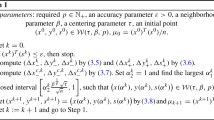Abstract
In this paper, we consider an optimal zero-forcing beamformer design problem in multi-user multiple-input multiple-output broadcast channel. The minimum user rate is maximized subject to zero-forcing constraints and power constraint on each base station antenna array element. The natural formulation leads to a nonconvex optimization problem. This problem is shown to be equivalent to a convex optimization problem with linear objective function, linear equality and inequality constraints and quadratic inequality constraints. Here, the indirect elimination method is applied to reduce the convex optimization problem into an equivalent convex optimization problem of lower dimension with only inequality constraints. The primal-dual interior point method is utilized to develop an effective algorithm (in terms of computational efficiency) via solving the modified KKT equations with Newton method. Numerical simulations are carried out. Compared to algorithms based on a trust region interior point method and sequential quadratic programming method, it is observed that the method proposed is much superior in terms of computational efficiency.




Similar content being viewed by others
References
Caire, G., Shamai (Shitz), S.: On the achievable throughput of multiatenna Gaussian broadcast channel. IEEE Trans. Inf. Theory. 49, 1691–1706 (2003)
Wiesel, A., Eldar, Y.C., Shamai (Shitz), S.: Linear precoding via conic optimizaiton for fixed MIMO receivers. IEEE Trans. Signal Process. 54, 161–176 (2006)
Joham, M., Utschick, W., Nossek, S.: Linear transmit processing in MIMO communications system. IEEE Trans. Signal Process. 53(8), 2700–2712 (2005)
Peel, B.C., UtschickHochwald, B.M., Swindlehurst, A.L.: A vector-pertubation technique for near-capacity multiantenna multiuser communication-part I: channel inversion and regularization. IEEE Trans. Commun. 53, 195–202 (2005)
Sung, H., Lee, S.R., Lee, I.: Genearlized channel inversion methods for multiuser MIMO systems. IEEE Trans. Commun. 57, 3489–3499 (2009)
Spencer, Q.H., Swindlehurst, A.L., Haardt, M.: Zero forcing methods for downlink spatial multiplexing in multiuser MIMO chanels. IEEE Trans. Signal Process. 52(2), 461–471 (2004)
Choi, L.U., Murch, R.D.: A transmit prepocessing technique for multiuser MIMO systems using a decomposion approach. IEEE Trans. Wirel. Commun. 3(1), 20–24 (2004)
Udupa, P.S., Lehnert, J.S.: Optimizing zero-forcing precoders for MIMO broadcast systems. IEEE Trans. Commun. 55(8), 1516–1524 (2007)
Wiesel, A., Eldar, Y.C., Shamai (Shitz), S.: Zero-forcing precoding and generalized inverses. IEEE Trans. Signal Process. 56(9), 4409–4418 (2008)
Lee, S.R., Kim, J.S., Moon, S.H., Kong, H.B., Lee, I.: Zero-forcing beamforming in multiuser MISO downlink systems under per-antenna power constraint and equal-rate metric. IEEE Trans. Wirel. Commun. 12(1), 228–236 (2013)
Karakayali, K., Yates, R., Foschini, G., Valenzuela, R.: Optimal zero-forcing beamforming with per-antenna power constraints. In: Proceedings of the IEEE international symposium on information theory. Nice, France, pp. 101–105 (2007)
Teo, K.L., Goh, C.J., Wong, K.H.: A Unified Computational Approach for Optimal Control Problems. Longman Scientific and Technical, New York (1991)
Boyd, S., Vandenberghe, L.: Covex Optimization. Cambrige University Press, New York (2004)
Byrd, R.H., Gilbert, J.C., Nocedal, J.: A trust region method based on interior point techniques for nonlinear programming. Math. Program. 89(1), 149–185 (2000)
Byrd, R.H., Hribar, M.E., Nocedal, J.: An interior point algorithm for large-Scale nonlinear programming. SIAM J. Optim. 9(4), 877–900 (1999)
Waltz, R.A., Morales, J.L., Nocedal, J., Orban, D.: An interior algorithm for nonlinear optimization that combines line search and trust region steps. Math. Program. 107(3), 391–408 (2006)
Acknowledgments
This work was supported by a grant from the Australia Research Council and a grant from the National Natural Science Foundation of China (No. 11171079).
Author information
Authors and Affiliations
Corresponding author
Rights and permissions
About this article
Cite this article
Li, B., Dam, H.H., Cantoni, A. et al. A primal-dual interior point method for optimal zero-forcing beamformer design under per-antenna power constraints. Optim Lett 8, 1829–1843 (2014). https://doi.org/10.1007/s11590-013-0673-y
Received:
Accepted:
Published:
Issue Date:
DOI: https://doi.org/10.1007/s11590-013-0673-y




